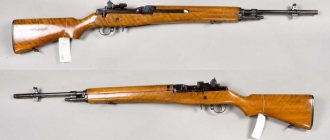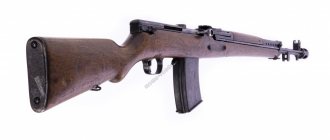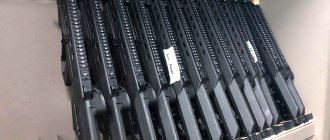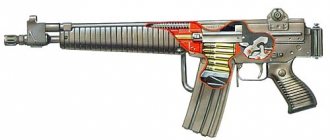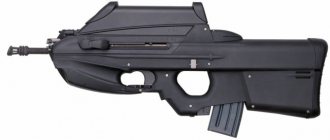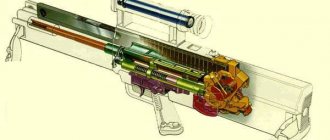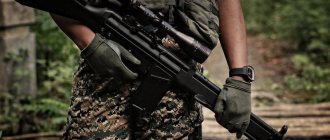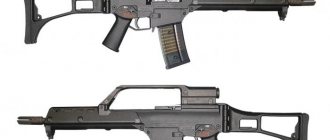| SIG SG 510 | ||
| Sturmgewehr 57 with rear sight, front sight, bayonet and folding bipod extended. Exhibited at the Morges Castle Museum. | ||
| Type | combat rifle | |
| Country of origin | Switzerland Chile | |
| Other names | Fass 57 (abbreviation of Fusil d' Ass aut 57 in French) Stgw 57 (abbreviation of S turm G and wehr 57 in German). | |
| service history | ||
| In service | 1957 - 1990 | |
| operators | See users | |
| wars | Coup d'etat in Chile in 1973 | |
| production history | ||
| Designer | Rudolf Amsler | |
| Creator | Swiss Industrial Society (SIG), Beretta | |
| Produced | 1957–1983 | |
| options | SG 510-1, SG 510-2, SG 510-3, SG 510-4 | |
| Characteristics | ||
| Weight | 5.7 kg (12.57 lb) (Stgw 57) 4.37 kg (9.63 lb) (SG 510-4) | |
| Length | 1100 mm (43.3 in) (Stgw 57) 1015 mm (40.0 in) (SG 510-4) | |
| barrel length | 583 mm (23.0 in) (Stgw 57) 505 mm (19.9 in) (SG 510-4) | |
| Ammunition | 7.62 x 51 OTAN 7.5 x 55 GP 11 (Stgw 57) | |
| Caliber | 7.62 mm 7.5 mm | |
| shooting system | Delayed return roller | |
| rate of fire | 450-600 shots/minute | |
| operating range | 640 m (700 m), with rear sight and front sight 600 m (656 m) Kern 4×24 optical sight | |
| Charger | curved retrievable, 20, 24 or 30 bullets | |
| Maximum speed | 750 m/s (2460 pcs/s) | |
| [edit data in Wikidata] | ||
SIG SG 510
or
Sturmgewehr 57
is a selective fire combat rifle manufactured by Schweizerische Industrie Gesellschaft (now SAN Swiss Arms) in Switzerland. It uses a roller-decelerated recoil system, similar to that used in the HK G3 and CETME rifles. It also has an automatic counterpart similar to the American Stoner 63.
SIG SG 510-1 entered service with the Swiss Army under the designation Fass 57
(abbreviation for
Fusil
d'
Ass aut 57 in
French
)
or Stgw
57
(abbreviation for
Sturm
Gewehr 57
in German).
The Sturmgewehr 57/SIG SG 510-1 was adopted by the Swiss Army in 1957 and was replaced by the lighter SIG SG 550 in 1990, although some reservists used it for several years.
design details
The SG 510 is a derivative of the AM55 used in the 1950s. It is a selective fire rifle that uses a roller delayed blowback system. Unusually, it was equipped with a shiny stainless steel bayonet.
Characteristics
The rifle is primarily composed of stamped sheet steel parts to facilitate mass production. The SG 510's bolt handle has a distinctive T-shape, similar to that of the earlier K31. The butt plate and fore-end of the rifle are covered with rubber, and the second has grooves for better grip.
The SG 510-1/Stgw 57 barrel has a length of 520 mm, the bore is rifled, with four grooves, the rotation speed of which is 270 mm (1 in 10.6 in). [1] The end of the barrel has a built-in muzzle brake that reduces recoil by 25%. The barrel is surrounded by a perforated tubular shroud with two bipod attachment points: one near the muzzle brake and one near the receiver.
A SIG SG 510-4, 7.62 51 OTAN.
The SG 510-4 uses the 7.62 x 51 NATO cartridge with a barrel rotation rate of 305 mm (1 in 12 inches), adopted by Chile and Bolivia. The SIG SG 510 is officially classified as an automatic rifle, but has served as a small arms weapon (in Chile equipped with a Supra 4 x 24 telescopic sight).
To reduce recoil, the fixed stock is equipped with a recoil damper. The SG 510-1/Stgw 57 has a large carrying handle at the balance point, which can be used for quick position changes or on the go. On the right side of the rifle is a folding "winter" trigger, allowing the operator to use the rifle with arctic mittens. It also improves accuracy because it reduces the force required to pull the trigger.
The trigger mechanism has a three-position fire switch, which is also a manual safety that prevents accidental discharge of the weapon. The user selects the operating mode via a large side lever on the left side of the receiver, which can be rotated to select S (safe), E (semi-automatic) or M (automatic).
Look
Swiss Army Stgw 57 with extended sight and PE57 bayonet.
The SG 510-1 Stgw 57 has a flush buttstock design and raised sights. Both rear sight and front sight can be folded when not in use. The Stgw 57 rear sight can be adjusted in the range from 100 m to 640 m. From 100 to 200 m the rear sight is adjustable in 50 m steps. From 200-300 m in 30 m steps and from 300-640 m in 20 m steps. [ 1 ]
According to the Swiss Army, the dispersion of a shot at 50% azimuth and elevation angle at 300 m from a remotely controlled installation averages 6 cm. [1] For anti-personnel use, the usual maximum firing range of the SG 510-1/Stgw 57 with sufficient accuracy is 600 m (656 yards).
For intended use, the SG 550 can be equipped with a Kern 4x24 quick-release optical sight. The sight weighs 730 g and includes many features such as mounting components, shot-drop compensator with height adjustment knob for ranges from 100 to 600 m, illuminated reticle , allowing target acquisition in low light conditions, and diopter correction. adjustment. The scope includes a hood for attaching to the eyepiece to reduce extraneous light that affects image quality, and a gray filter to reduce glare. [2]An infrared night vision sight can also be installed. The Chilean version can be equipped with the German Supra 4×24 optical sight.
Accessories
Stgw 57 with folded sights on the bipod.
The Swiss Army Stgw 57 is fed by curved detachable aluminum magazines with a capacity of 24 rounds. 20- and 30-round magazines are also available. Other accessories include a rifle sling, a PE57 bayonet and a special low-capacity magazine for throwing rifle grenades.
Rifle grenades can be thrown without much modification. The grenade launcher cartridges allow the SG 510-1/Stgw 57 to fire Gewehrgranaten 58 rifle grenades. The Gewehrgranaten 58 has a muzzle velocity of 35 m/s and a maximum range of 125 m without the aid of an accelerator charge, or 70 m/s and a maximum range of 400 m with the aid of an accelerator charge. Gewehrgranaten 58 can be equipped with the following warheads:
- Shaped charge for heavy armor. Modern shaped charge rifle grenades can penetrate 300 to 500 mm (12 to 20 in) of "best quality" armor;
- Anti-personnel, with impact detonator.
- Smokey to reduce visibility.
- training
Assault rifle Stgw.57 / SIG 510
Home | Weapons | Assault rifles | Switzerland | Stgw.57/SIG 510
Stgw.57/SIG 510
Assault rifle Stgw.57
Assault rifle Stgw.57 chambered for 7.5×55
The Stgw.57 or Sturmgewehr 57 rifle in 7.5 mm caliber was developed by the design team led by Rudolf Amsler at the Schweizerische Industrie Gesellschaft (currently SAN Swiss Arms). In 1957, the Sturmgewehr 57 was adopted by the Swiss Army. In addition, the Stgw.57 was simultaneously produced for export for the civilian arms market in a self-loading version, capable of firing only single shots. The main disadvantages of the Stgw.57 were the very high cost and large mass of the weapon. The advantages were high Swiss manufacturing quality, long service life, ease of use and excellent accuracy.
Assault rifle SIG 510-4
The automatic operation of the SIG 510-4 rifle operates according to a semi-blowback design. At the beginning of the bolt's retreat, its speed is reduced by the interaction of the bolt's combat cylinder and two rollers with the bolt box. The weapon is equipped with a folding trigger, which in the unfolded position protrudes from the lower wall of the trigger guard, for shooting with thick winter gloves. For the same purpose, the cocking handle, located on the right side of the weapon, is made large and voluminous, in the shape of a barrel. The barrel casing has folding bipods. All rifles have a Kren 4X24 scope mount.
SIG 510-4 assault rifle chambered for 7.62×51
Based on the SIG 510-4 model, the SIG AMT (American Match Target) self-loading rifle was created for the civilian weapons market, which was exported to the USA and differed from the automatic army model, except for the trigger, in the absence of guides on the barrel for rifle grenades and a bayonet mount.
Stgw 57 (Sturm Gewehr 57 - assault rifle model 1957) or SIG SG 510 - Swiss automatic rifle, released by SIG (Schweizerische Industrie Gesellschaft) in 1957.
In the 1950s, the famous Swiss company SIG (Schweizerische Industrie Gesellschaft) developed the AM 55 automatic rifle chambered for the Swiss GP11 cartridge (7.5x55 mm), the design of which used the semi-blowback recoil principle. The basis for the development of a new weapon for designer Rudolf Amsler was the German assault rifle Stg 45.
In 1957, after minor modifications, the new automatic rifle was adopted by the Swiss army under the designation Stgw 57 (Sturm Gewehr 57 - assault rifle of the 1957 model). The Stgw 57 rifle entered the commercial arms market with the designation SIG SG 510. The Stgw 57 assault rifle uses the recoil principle of a semi-free bolt consisting of two parts. Slowing down the shutter release under the influence of recoil is carried out using rollers. On the right in the groove of the receiver there is a convenient T-shaped cocking handle.
To cock the weapon, you need to pull back and release the T-shaped handle, while the bolt moves forward, sending the cartridge into the chamber. The hammer is cocked and held by the sear. The shutter consists of two parts: the stem and the larva. Rollers of an unusual design are installed on the larva: small shaped parts are hinged on the cylindrical roller itself. When the cartridge enters the chamber, the cylinder stops, and the bolt stem continues to move and passes between the rollers. The shutter mirror is wedge-shaped, and the rollers are forced into the grooves of the receiver.
When fired, the spent cartridge moves backward. The inner surface of the chamber has longitudinal grooves that allow powder gases to pass to the shutter mirror. It has two holes through which gases pass through the larva and press on the stem of the bolt. The pressure of the cartridge case and the powder gases forces the rollers to move inward along the inclined surfaces of the bolt stem. Due to the angles of inclination of the wedge-shaped surface, the stem of the shutter is forced to move backward and disconnect from the larva.
When the rollers come out of the grooves, the shutter, in a disconnected state, continues to roll back. The fired cartridge case is pressed against the shutter mirror by the ejector. It is hinged on the upper part of the combat cylinder; when the bolt is rolled back, it rests on an inclined ledge on the left side of the receiver, as a result of which the cartridge case is thrown out through a window on the right side of the receiver. This design ensures smoother operation of the mechanism during cartridge ejection.
The trigger mechanism is of a simple design and, unlike most modern rifles of that period, was not borrowed from the M1 Garand model. It uses a sear with a cutout for the axle rod and a constant spring. The trigger is a stamped part with a protrusion at the rear. When pressed, the protrusion raises the rear of the sear, causing the sear tooth to emerge from the cutout in the hammer, and the hammer strikes the firing pin. In single-fire mode, the sear moves forward under the action of a spring and disengages from the trigger protrusion. As the hammer moves rearward, it engages the sear cutout. Under the action of the trigger spring, it moves back all the way. The next shot can only be fired after pressing the trigger again, since the sear is released only when the hook moves forward. After this, the process is repeated, provided that the stem of the shutter along with the larva is in the closed position.
In continuous fire mode, the protrusion of the trigger rises significantly higher and forces the sear tooth to go further, as a result of which the trigger, when moving back, is captured not by the trigger sear, but by the safety one, and is held in the rear position until the rear of the bolt forces the rollers to engage cutouts. Thus, shooting can be continued with the bolt fully closed, which serves as another safety device. When the fire mode selector is set to the “safety” position, the trigger is locked in the lower position. During firing, the trigger strikes an L-shaped hinged arm, which in turn strikes the firing pin.
The “Arctic” trigger, designed for shooting with thick gloves, is permanently installed and is also used when firing a rifle grenade. Under normal conditions, it folds along the receiver. The receiver of the Stgw 57 is made by stamping and reinforced at the rear for attaching the butt and accommodating the return spring. The breech of the barrel is attached to the front part and guide rollers are placed, which can be replaced when worn out. The barrel is made by cold forging and is equipped with a muzzle brake, which also serves as a flame arrester.
At the front end of the barrel there are rings that serve as guides for firing a rifle grenade. A rifle grenade is fired using a blank cartridge, and a special magazine is installed instead of the standard one. Mounts for a bayonet are provided under the barrel. The barrel is covered with a perforated casing on which a folding bipod can be installed. The folding bipod, when unfolded, can be installed in two positions - under the muzzle of the barrel or next to the receiver.
The cylindrical front sight and aperture rear sight are mounted on folding stands; the sight is equipped with a drum with fixed settings. The required range can be set using clicks. The front sight can be moved left and right, up and down using a special key. In addition, automatic rifles Stgw. 57 could be equipped with optical or night sights.
The weapon was fed from standard detachable box magazines with a capacity of 24 rounds. The rifle has a fixed plastic stock with a built-in recoil buffer. In addition, the weapon is equipped with a handle for carrying the rifle.
In total, about 500,000 units of military variants and about 7,000 of civilian ones were produced.
In general, the weapons of the SIG 510 family were distinguished by very high reliability, excellent shooting accuracy and ease of use. The main disadvantages of the weapons in this series were the significant mass of the weapon and its excessively high price.
In the 1980s, most of the Stgw 57 assault rifles were withdrawn from service and replaced by the newer SIG 550 / Stgw 90 models.
Options: SG 510-1 - basic version. SG 510-2 is a lightweight version. SG 510-3 - version chambered for the Soviet cartridge 7.62x39 mm. It was developed to participate in a competition for a new machine gun for the Finnish Army. SG 510-4 is an export version chambered for the 7.62x51 mm NATO cartridge with a modified handle, forend, butt and sights, a shortened barrel and straight magazines for 20 rounds. SIG PE-57 is a self-loading version of the SG 510-1 for the Swiss civilian market. SIG AMT (American Match Target) is a self-loading version of the SG 510-4 for the US civilian market. It did not have a bayonet mount or guides for rifle grenades.
Specifications
Caliber: 7.5×55 (7.5×55 GP11) - for Stgw.57 and 7.62×51 - for SIG 510-4
Weapon length: 1016 mm
Barrel length: 505 mm
Weight without cartridges: 4.2 kg.
Rate of fire: 600 rounds/min
Magazine capacity: 24 (Stgw.57) / 20 (SIG 510) rounds
Assault rifles
- Austria
- Brazil
- Czech
- South Korea
- South Africa
- France
- USA
- Singapore
- Spain
- Russia/USSR
- Australia
- Finland
- Germany
- Türkiye
- Switzerland
- Denmark
- Japan
- Israel
- Sweden
- Indonesia
- Belgium
- Poland
- Ukraine
- Italy
- Croatia
- Iran
- Dominican Republic
- Mexico
- Serbia
- Argentina
- China
- Canada
- Taiwan
- Great Britain
civil use
Upon completion of their military service, members of the Swiss Armed Forces could own their own personal SG 510 rifle by paying an administration fee. These "civilized" rifles were converted to fire only in semi-automatic mode. As of 2007, 40% of released soldiers decide to keep their weapon (currently the SIG SG 550), with the price of "civilized" SG 510 rifles reported to range between CHF 400 and 500 on the private arms market. [3]
In Switzerland the SG 510 is also used for shooting competitions. To do this, standard aiming mechanisms can be replaced with diopter rear sights and tubular front sights. When the aiming radius remains the same, Swiss sport shooters call this modified rifle the Stgw 57/02. When the radius of the line of sight was increased by installing a tubular front sight near the muzzle, the rifle was named Stgw 57/03.
Accuracy potential[edit]
The following tables provide accuracy statistics for typical in-service Stgw 57 rifles firing 7.5×55mm Swiss GP 11 service ammunition as measured by the average shooter. The statistics were calculated using the 1950s Swiss accuracy method, which is more complex than Western methods, which typically involve firing a group of shots and then measuring the overall diameter of the group. The Swiss method differs in that after a group of shots at a target from a machine with a rest, hits on the outer part of the target are not counted, but only half of the hits on the inner part of the circles are counted (50% or R 50), which significantly reduces the overall diameter of the groups. Vertical and horizontal measurements of the reduced groups are then used to measure accuracy. This circular error probability method used by Swiss and other European militaries cannot be converted and is not comparable to US military methods for determining rifle accuracy. When R 50 results are doubled, the hit rate increases to 93.7%.
Example distribution of probable 20 matches with circular error
| Single shot dispersion with Swiss GP 11 service ammunition. | ||||
| Classify | Horizontal accuracy of fire (R 50) | Vertical accuracy (R 50) | ||
| 0 m (0 yd) | 0 cm (0.0 in) | 0 cm (0.0 in) | ||
| 100 m (109 yd) | 5 cm (2.0 in) | 5 cm (2.0 in) | ||
| 200 m (219 yd) | 9 cm (3.5 in) | 9 cm (3.5 in) | ||
| 300 m (328 yd) | 14 cm (5.5 in) | 14 cm (5.5 in) | ||
| 400 m (437 yd) | 18 cm (7.1 in) | 20 cm (7.9 in) | ||
| 500 m (547 yd) | 22 cm (8.7 in) | 27 cm (10.6 in) | ||
| 600 m (656 yd) | 27 cm (10.6 in) | 34 cm (13.4 in) | ||
| Average dispersion of 4-6 shots with Swiss GP 11 service ammunition. | ||||
| Classify | Horizontal accuracy of fire (R 50) | Vertical accuracy (R 50) | ||
| 0 m (0 yd) | 0 cm (0.0 in) | 0 cm (0.0 in) | ||
| 100 m (109 yd) | 23 cm (9.1 in) | 17 cm (6.7 in) | ||
| 200 m (219 yd) | 47 cm (18.5 in) | 33 cm (13.0 in) | ||
| 300 m (328 yd) | 70 cm (27.6 in) | 49 cm (19.3 in) | ||
| 400 m (437 yd) | 94 cm (37.0 in) | 66 cm (26.0 in) | ||
| 500 m (547 yd) | 118 cm (46.5 in) | 82 cm (32.3 in) | ||
| 600 m (656 yd) | 1141 cm (449.2 in) | 99 cm (39.0 in) | ||
- R 50 means that the next 50 percent of the shot group will be within a circle of the specified diameter.
- R 93.7 means that the nearest 93.7 percent of the shot group will be within the circle of the specified diameter.
- The spread of a single shot was determined from the bipod in the rear position.
- The order spread of 4-6 shots is determined by the more stable bipod in the forward position.
For reference, a 1 minute of arc (MOA) circle at 300 m (328 yd) has a diameter of 8.72 cm (3.4 in), and at 600 m (656 yd) the diameter is 17.44 cm (6. 9 inches). The radius of a circle is equal to half its diameter.
options
- 510-1: Swiss Army standard rifle.
- 510-2: A lightweight version of the standard assault rifle. [ 4 ]
- 510-3: Short-barreled version 7.62x39. It was produced as a prototype in small numbers and offered to the Finnish army. They didn't want that, so this model was never produced. [ 4 ]
- 510-4: 7.62 x 51 NATO variant, used by Bolivia and Chile.
- AMT: The semi-automatic variant is imported into the US in small quantities. It was available in both 7.62 x 51 (.308 Winchester) and 7.5 x 55 Swiss GP 11, which was less common. “AMT” is an acronym for “American Match Target.” It was equipped with a thin wooden stock and a rounded wraparound forend.
- SIG PE 57: Civilian semi-automatic version, available only in 7.5x55 Swiss GP 11 caliber. This variant differs from retired Swiss Army and custom assault rifles.
SG 510-4 7.62×51mm NATO variant[edit]
The SG 510-4 rifle chambered for 7.62×51mm NATO
The SG 510-4, chambered for 7.62×51mm NATO with a 304.8 mm (1 in 12 in) barrel, was adopted by Chile and Bolivia. Compared to the SG 510, the following changes have been made:
- Lighter and shorter barrel with 8 (early) or 16 (late) grooves
- New low-profile iron sights with ramp-adjustable rear sight and semi-closed front sight
- Spring-loaded retainer on the front barrel housing bushing/front sight base for rifle grenade launcher sights
- Angled stock, barrel and stock, with suitably modified recoil spring assembly
- Walnut stock and forend
- Lightweight roller notches and winter trigger
- Simplified bolt carrier with superstructure, unified rubber shock absorber and charging handle eye
The SIG SG 510-4 is officially classified as an automatic rifle, but has also been used as a dedicated small arms weapon (in Chile with a Supra 4×24 telescopic sight).
Images
- Stgw 57/03, modified for sport shooting, with diopter extension and tubular front sight.
- Receiver Stgw 57, right view.
- Gearbox Stgw 57/03, modified for sports shooting, left view.
- Stgw 57 without weapons
- Shutter and return spring Stgw 57.
- Trigger from Stgw 57 with extended winter trigger.
- Bayonet and scabbard with belt Stgw 57
- Cleaning crew Stgw 57
Links and footnotes
Explanatory Notes Footnotes
- ↑ a b c
Swiss Army Guide to the Sturmgewehr. Archived November 9, 2013, at the Wayback Machine. (German) - Optical sight Kern 4×24
- Stefan von Below (19 October 2007). “The rifle costs 60 francs and five crosses.” Testament
. paragraph 21 - ↑ a b c
Stgw. 57/Sig 510 Assault Rifle (Switzerland). Archived November 20, 2005 at the Wayback Machine. - ↑ a b c
Jones, Richard D. Jane, Infantry Weapons 2009/2010. Jane Information Group; 35th edition (January 27, 2009). ISBN 978-0-7106-2869-5. - Gillette, Jacques (2005). Personal Guard of the Princes of Monaco
(1st edition). Taurus Editions. ISBN 2912976-04-9.
Bibliography
- Maxim Popenker, Anthony G. Williams: The assault rifle is a development of the modern military rifle and its ammunition. Rambsbury, Wiltshire, UK, 2004. ISBN 1-86126-700-2. (in English)
- Press release of the General Staff dated February 27, 1997 (in English)
- Rolf Abresch, Ralf Wilhelm: Modern small arms of the Bundeswehr, Report Verlag, Frankfurt a. M. 2001. ISBN 3-932385-10-1 (in English)
external reference
- Wikimedia Commons contains a multimedia category for GIS SG 510
. - Modern firearms: SIG SG 510 assault rifle.
- Biggerhammer.net: SIG 510.
- Swissrifles.com: SIG SG 510 (in English).
- Exordinanza.net: StGw 57 (in Italian).
- Portal for Swiss rifles Stgw 57/SG 510/AMT and SG 550 (in English).
- Cartridge 7.5x55 Swiss.
| authoritative control |
|
- Data: Q267108
- Multimedia: SIG SG 510

